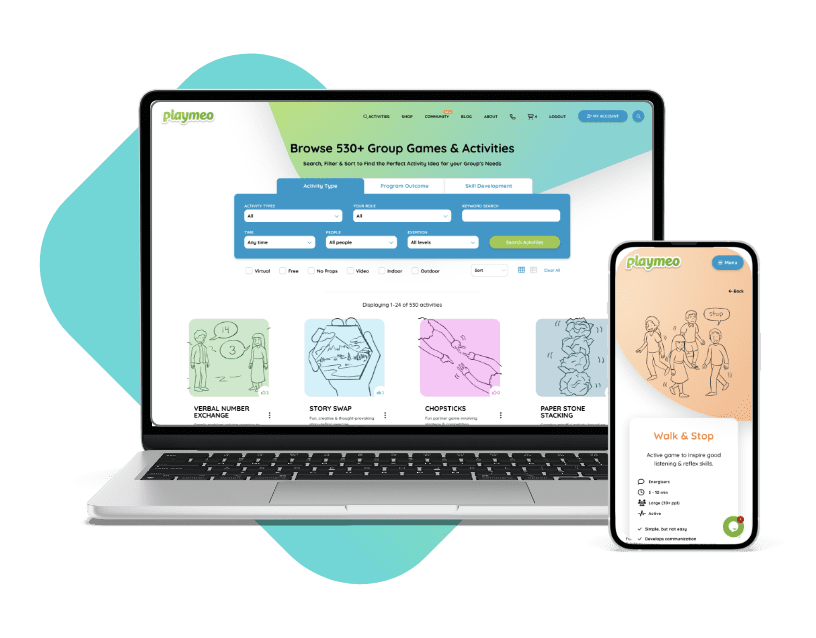Download our free 28-page ebook jam-packed with outrageously fun activity ideas.
The process of setting goals, and working towards them, is very clearly and unquestionably beneficial to your program. It answers the ‘Why?’ question driving your program.
Research has repeatedly shown that groups achieve more when they set a goal because goals motivate people as much as guide and direct their energy towards a common objective.
A program goal may sound like… to have fun, to build team skills, to energise and wake up the group, to develop leadership skills, to prepare the group for a certain task, to fill in time, to open the conference, and so on.
Now, having answered the Why? question, this is the point where most program leaders conclude their goal-setting process.
This is a start, and there is nothing wrong with choosing to stop here. You have a goal, and this is better than not having a goal. But, having a goal is not the same as making a difference.
Articulating The Difference
A poor process to setting an effective goal, or worse, the absence of a goal, are two of the main reasons programs fail. In my goal-setting endeavors, I have found it useful to follow the SMART Goal guidelines to set effective goals.
The R of the SMART goal-setting model points to a little of the depth required of this final planning step. It asks the why behind the why.
You can’t make a difference without, first, understanding why this difference will matter to your group. Once again, recalling a simple truth – you cannot change how people think or what they do without, first, changing how they feel.
This part of your needs analysis aims to go deeper, to a level which, once tapped, will unlock the true value of your program and more successfully engage your group on their journey with you. This is so important. When you nail this ‘difference’ you’ll be able to identify exactly how you want your group to feel when they leave your program.
There is no set formula, simply an enquiry. There are several tools you can use to drill down deeper, including:
- The Five Whys – a simple problem-solving technique that helps you get to the root of a problem quickly. Ask a series of ‘why?’ questions with each successive answer to help you understand why your group wants to achieve this particular goal, why this is important to them and to whom this matters.
- Empathy Enquiry – a series of questions that help you understand an experience as viewed through the eyes of your group. It helps you explore why people do what they do, and build empathy for how they think and how they behave. In essence, it explores the purpose, beliefs, values and worldview of your group.
In short, your program will be well served if you can clearly articulate what difference you are going to make. How will this make your group feel, and what do you want them to become?
How To Set Group Goals
Setting goals is more than just facing everyone in the same direction, though. It’s about giving people a reason to participate especially if their (or your program) goal sits outside of their Comfort Zone.
To this end, it is particularly powerful to involve your group in the goal-setting process (if possible) because this choice will give them more control of, and allow them to feel more responsible for, the final result.
Goals can be explicit or implicit, casual or very formal. They are the lens through which every exercise and interaction should be viewed as you design and deliver your program.
Short programs – such as conferences and business meetings – tend to adopt very simple, often implicit goals, whereas longer programs – such as a classroom, the development of a healthy organisational culture and weekly youth group meetings – always benefit from investing more time and effort to the process.
Here are five of my favourite methods or techniques for setting goals with my groups.
1. Personal Action Plan
I ask each person to write down and/or respond to the following four questions:
-
- What do you want to accomplish during this program, and why does this matter to you?
- How will you accomplish your goal, and what actions are you willing to take?
- What resources and support from others will help you achieve your goal?
- How will you know if you have reached your goal, i.e., what will it look, feel, and sound like?
2. Palm Tree
I ask each person to place their hand palm-down on a single large sheet of paper and trace around the perimeter of their hand with a marker. Encourage every hand-print to touch at least one other hand-print (to build a metaphor of inter-connectedness.) I then ask each person to write one goal (or feeling that matters to them) inside their hand-print and sign their name. After sharing these goals with one another, we post the sheet in a prominent place to keep the goals in existence.
3. The Being
One person lies down, face-up, on a large sheet of paper (or several pieces taped together). Carefully, the rest of the group traces around the perimeter of this person. The person gets up. I instruct each person to write one goal along the traced edge of ‘the being.’ Then we write as many attributes of healthy relationships on the inside of the being and on the outside all of those things which get in the way of healthy relationships. After a thorough discussion of the merits of what has been written, we post the being in a prominent location.
4. Partner Introductions
In pairs, I ask my group to spend five minutes getting to know their partners. Normally, they can share anything they wish, but I typically ask that they extract three specific bits of information – their name, a favourite movie and a professional goal they would like to achieve during the program. Upon returning to the large group, I ask each person to introduce their partner (not themselves) to the rest of the group.
5. Moonball
Each person writes one effective team-oriented attribute on a beach ball. We discuss the value of each attribute and then commit to upholding them. Then, I present an initiative – for the group to keep the ball off the ground for as long as possible, by hitting it with an open hand. Scoring a point for each hit, the group is challenged to reach a target, or score the highest possible score. Making several attempts, the score returns to zero each time the ball lands on the ground. To conclude, my debrief connects the attributes written on the ball with the way the group worked together to achieve their goal, ie did they ‘uphold’ their values or not?
Essential Tools
Setting goals is just one of a set of five essential tools I intentionally use to help groups can amplify whatever they’re trying to get done.
You can learn more about playmeo’s innovative approach to education by clicking the links below.
- FUNN (Functional Understanding Not Necessary)
- Honouring Choice
- Leveraging Full Value
- Learning Through Reflection
This article about Setting Goals has been adapted from No Props No Problem: 150+ Outrageously Fun Group Games & Activities Using No Equipment and Serious Fun: Your Step-by-Step Guide to Leading Remarkably Fun Programs That Make a Difference.






